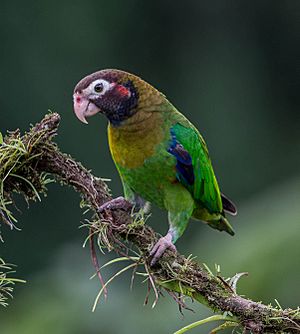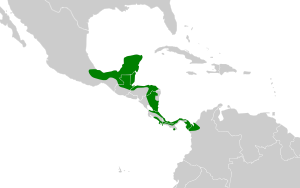Brown-hooded parrot facts for kids
Quick facts for kids Brown-hooded parrot |
|
|---|---|
 |
|
| Conservation status | |
| Scientific classification | |
| Genus: |
Pyrilia
|
| Species: |
haematotis
|
 |
|
| Synonyms | |
|
Pionopsitta haematotis |
|
The brown-hooded parrot (Pyrilia haematotis) is a colorful bird found in the Americas. It belongs to the parrot family, specifically the group of parrots from Africa and the New World. You can find these parrots living in an area stretching from Mexico all the way down to Colombia.
Contents
What is a Brown-Hooded Parrot?
The brown-hooded parrot is a medium-sized bird, usually about 21 to 23 centimeters (8 to 9 inches) long. It weighs around 145 to 150 grams (5.1 to 5.3 ounces).
How to Identify a Brown-Hooded Parrot
Adult brown-hooded parrots have some unique features:
- Their head, including the top of their head, ear feathers, and throat, is a reddish-brown color.
- They have a pinkish-red patch right behind their eyes.
- Their nostrils and the ring around their eyes are white.
- The back of their neck and their chest are a dull olive-yellow color.
- Their sides are red.
- Most of their body is green.
- The edges of their wings are blue, and their flight feathers (the long ones used for flying) are a dark bluish-black.
- The tips of their tail feathers are also blue.
There is a special type of brown-hooded parrot called P. h. coccinicollaris. This type has some extra pinkish-red color below its dark throat. Sometimes this red color even goes all the way around its neck.
Do Young Parrots Look Different?
Yes, young brown-hooded parrots look a bit different from adults. They have a lighter-colored head and do not have the red patch behind their eyes. Their chest is also more green than the adults'.
Where Do Brown-Hooded Parrots Live?
Brown-hooded parrots live in different parts of Central and South America.
Geographic Distribution
The main type of brown-hooded parrot, called P. h. haematotis, lives in:
- Southeastern Mexico (in areas like Veracruz and Oaxaca).
- South along the Caribbean coast through Belize, Guatemala, Honduras, and Nicaragua.
- On both sides of Costa Rica and western Panama.
The other type, P. h. coccinicollaris, is found from near the Panama Canal into northwestern Colombia. This includes regions like Chocó, Antioquia, and Córdoba.
What Kind of Places Do They Call Home?
These parrots prefer to live in the tops of trees (the canopy) and at the edges of certain types of forests:
- Humid evergreen forests (forests that stay green all year).
- Cloudforests (forests that are often covered in clouds).
- Mature secondary forests (forests that have grown back after being cut down).
They usually live from sea level up to about 1,200 meters (3,900 feet) high. However, sometimes they can be found as high as 1,900 meters (6,200 feet).
How Do Brown-Hooded Parrots Behave?
Brown-hooded parrots have interesting habits, especially when it comes to moving around and finding food.
Do They Move Around?
Scientists believe that brown-hooded parrots might move to different elevations depending on the season. For example, in Costa Rica, they seem to move to lower areas after they have finished breeding in higher places.
What Do They Eat?
These parrots look for food high up in the trees and at the forest edges. Their diet mainly consists of:
- Fruits and seeds from trees.
- Fruits and seeds from epiphytes (plants that grow on other plants, like air plants).
- They especially love eating figs from Ficus trees.
- They have also been seen eating the leaves of mistletoe plants.
How Do They Raise Their Young?
The exact time when brown-hooded parrots breed can be different depending on where they live. They build their nests inside holes in trees. However, many details about their breeding are still a mystery. We don't know how many eggs they lay, how long the eggs take to hatch, or how long it takes for the young birds to be ready to fly. We also don't know much about how the parents care for their babies.
What Do They Sound Like?
Brown-hooded parrots make different sounds:
- When they are flying, their call sounds like a clear "kee-reek" or "curicu-reek." It can also sound like a high-pitched "chreea, cheea."
- When they are sitting on a branch, they make other pleasant sounds. These can range from loud yelps to various gurgling and squeaking noises.
Are Brown-Hooded Parrots in Danger?
The IUCN (International Union for Conservation of Nature) has looked at the brown-hooded parrot's situation. They have decided that it is a species of "Least Concern." This means it is not currently considered to be in serious danger of disappearing.
Why Are They Not in Danger?
- They live in a very large area.
- There are at least 50,000 adult brown-hooded parrots, though this number is thought to be slowly going down.
- The only real threat identified is logging (cutting down trees) in their habitat. However, this threat does not seem to be very severe.
- These parrots are quite common in many parts of their range.
- They are not often hunted or trapped by people.
See also
 In Spanish: Lorito encapuchado para niños
In Spanish: Lorito encapuchado para niños


